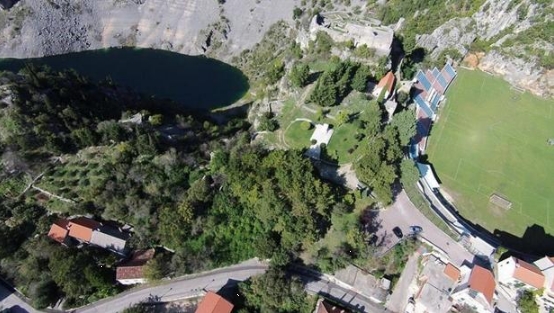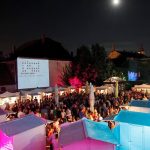Whisper it quietly, but the Dalmatian town of Imotski is coming in from the cold, both in terms of tourism and quality wine production, as the assembled group of international journalists on the Zagreb Vinocom discovered on November 26, 2014, on the third and final day of their regional tour of Croatia’s wine regions ahead of the Vinocom wine fair, which started in the capital yesterday.
The 30 wine journalists, who come from 18 countries as far away as Indonesia, Russia, Israel and America, had already visited the island of Brac and the island of Hvar before heading to the historic town of Imotski close to the border with Bosnia and Herzegovina.
Imotski has been traditionally regarded as a mass producer of ordinary wine, perhaps best symbolised by the giant Imota winery (which was once the second largest in all of former Yugoslavia with an annual production of some 20 million litres), the region’s wine fortunes are being mirrored in its tourism industry due to some significant infrastructure improvements to improve access. The opening of the stretch of motorway from Split to Dubrovnik close by Imotski has made the town much more accessible overnight, while the opening of a tunnel from the coastal resort of Makarska has had a significant impact on tourism, and wine tourism in particular.
Where once the trip to Imotski from the coast would have taken more than an hour, the journey time from Makarska — one of Dalmatia’s most popular coastal resorts — takes less than 30 minutes. More than one million cars have travelled through the tunnel since it opened, including an increasing number of tourists keen to see the infamous Red and Blue Lakes in Imotski, as well as sample local Croatian wines. Wine tourism to the best known winery in the Imoski region, Grabovac, has seen a four-figure increase in the first year of the tunnel’s operation, a trend which is set to continue.
Wine tourism can only succeed with a quality product, and as the international group learned over an informal dinner at a traditional mill on arrival, great progress has been made in lifting the quality and diversifying the varieties of the region, in addition to the dominant local white variety of Kujundzusa.
The undisputed catalyst for this transformation, and a leading and active member of the 51-winery Imotski Wine Association, is the Grabovac winery in Donji Prolozac. Established in 1994, it was the first privately-owned winery in the region, continuing the Grabovac family wine tradition of more than 200 years. In addition to its range of 12 still wines, Grabovac has produced the first commercial sparkling wine in Dalmatia, an excellent combination of Pinot Gris, Chardonnay and Sauvignon Blanc, while it has also introduced other international varieties such as Merlot, Cabernet Sauvignon and Syrah in addition to local varieties of Kujunszusa, Posip, Zilavka, Vranac and Trnjak. Keen to blend and experiment, the visit to the Grabovac winery made a clear impression on the international wine experts.
The basement of traditional Dalmatian stone houses, known as a “konoba,” is an important part of the Dalmatian wine story, and the following morning started with a walking tour of the centre of Imostki and a visit to the Jagul Wine Cellar. One of the best preserved and expansive konobas in the region, the konoba is home to the wines of Glavota, who encountered an unusual problem with Croatia’s entrance into the EU last: almost half of his vineyards were located across the border and outside EU-territory, in neighbouring Bosnia and Herzegovina. After some initial difficulties, the Ministry of Agriculture granted him a special exemption to bring the grapes over the border.
While wine was the main theme of the trip, the group had time to visit the spectacular Red and Blue lakes of Imotski, the town’s most famous attraction. Located in the centre of town, the Blue Lake has a variable water level, which changed up to 100 metres depending on the season, and where arguably the world’s most unusual football match takes place at the bottom of the lake when it dries out completely (see video below).
From small family winemakers to one of former Yugoslavia’s biggest wine names, the short drive to the Imota winery revealed yet more surprises. Once the second-largest winery in former Yugoslavia with an astonishing 20 million litres a year, today the publicly listed company produces just 5 percent of that, and while the expansive grounds of the winery had clearly seen better times, the presentation room held a spectacular discovery in addition to the 21 wines for tasting by the Imotski Wine Association.
Three of the four walls were adorned in a giant mosaic portraying the town of Imotski, its nature and traditions. Four years in construction, it is the work of artist Slobodana Matic, and comprises 450,000 pieces from five continents, all of natural colour. Although it was finished in 1980, there is almost no information about it online. The professional tasting of the wines of Imostki was conducted by Zoran Pejovic of Paradox Hospitality in Split.
Some 21 wines and a good lunch later, the group departed for Zagreb for the opening day of the wine fair, via a tasting in Skradin with Alen Bibich, who became very familiar to American audiences a couple of years ago for his impressive tasting with Anthony Bourdain in his ‘No Reservations’ culinary tour of Croatia.



.jpg)
.jpg)
.jpg)
.jpg)
.jpg)
.jpg)
.jpg)
.jpg)








